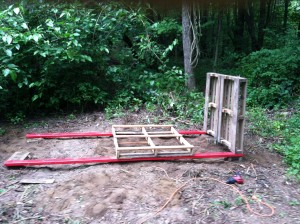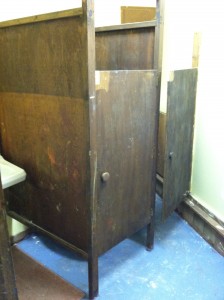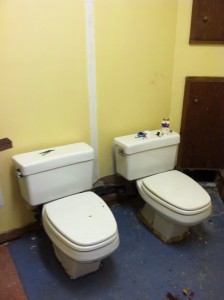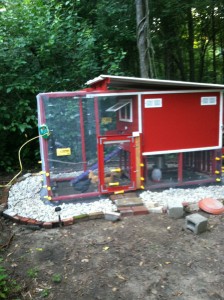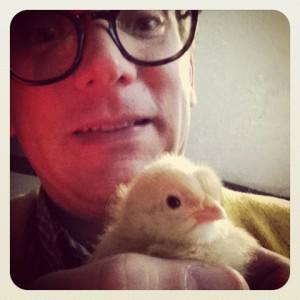Too Many Chickens! January 11, 2013
Friday, January 11th, 2013Here’s this week’s segment, with some pictures. Added value!
So you’ve got your chickens, now what do you do with them? Put them in the coop, right? You have a coop, right? I did not have a coop. Everyone says, “Don’t get chickens until you have a coop,” but then you read a little more, and it seems like lots of people still get the chickens first. I was not alone, in concept. I was very alone in practice.
You actually don’t just throw them in the coop right off the bat. Baby chicks need a lot of care and warmth until they “feather out,” (or lose the fuzziness that makes them so cute). But that’s good, because it buys you time to build the coop you have to have. They sit in a “brooder” under a heat lamp for a while, unaware of just how much stress the new home they don’t even know about is causing.
I could have just bought a coop, I suppose. That might have been the easy thing to do. Easy isn’t always cheap, though. Especially when you have crossed some sort of imaginary line about how many chickens is a lot. When I got the chickens, six seemed ok. When I actually looked into getting them a coop (which I did also do before I got them, I just wasn’t paying close enough attention, I guess) I would have noticed that most small coops hold up to five. After that, you’re in a different class of coops. A ridiculously expensive class of coops. Not that the small ones are cheap either, but room for one more chicken seemed to double the expense. That is an expensive chicken.
Given that the right size coop cost more than my car (I have a very old car, but still) I decided I would have to do this on my own. Did I know what I was doing? No. Has this stopped me before? No. Should it have? Probably. But I did it anyway. I spent most of my summer weekends and a few vacation days working on this. And I never remembered to put on sunscreen until at least an hour into it each time.
I originally had planned on using pallets as the framework. You can get those for free, which seems like a good deal to the budget coop builder. However, they’re also very heavy, and for some reason I couldn’t find many that were the same size. Some sort of modernist coop with odd sized walls and a severe tilt was certainly appealing, but I knew the limits of my skills. Chances were that even with matching pallets this thing would come out all cock-eyed, so I reconsidered my plan.
We have a room in our house that used to be a day care. The bathroom in that room has two toilets, each in their own wooden stall. I hated these. They were stained very dark, and it was depressing. One day I started to rip them out, and it dawned on me that here was a bunch of perfectly good wood that was already matched in size. The coop project started to look up. The stall walls became the sides of the coop, and the stall doors became the front and back. They already had hinges, so now I could use them as doors to get in and out of the coop, as needed. And a bonus was that with the stalls gone, we now had two toilets right next to each other, which I like to call “Lover’s Toilets.” You and a loved one can sit together and hold hands while you do your business, if you so choose. My loved ones have not taken me up on this offer.
So I had a wooden box, now what? The chickens need to have a run. I intended to let them out in the yard to lay waste to the local tick population, but during the day when I’m not around, they needed a safe place to roam. We’ve got pretty much every predator New England has to offer around here, so I wasn’t about to open a chicken buffet, if I could help it. The run is basically another wooden box, but with some sort of wire netting for walls. This keeps your chickens in, and more importantly, it keeps everything else out. Oddly enough, “chicken wire” is not the best thing for this task. It keeps the chickens in, but it doesn’t necessarily keep other things out. It’s easy to chew through, and the go-to horror story involves a raccoon that pulls chickens through the holes in the wire, one handful at a time. To avoid this, you need hardware cloth, which is made up of tiny metal squares. Hardware cloth is a great thing. Unfortunately, it is also an expensive thing. This is where about 80% of the coop expenses came from. But it’s also a thing you just can’t skimp on.
Things began to come together, if slowly. The fact that we had live chickens in our storage room getting bigger by the minute is the only thing that kept me going sometimes.There was no shortage of dark moments. When I write, I experience something I have come to call “mid-project depression.” I reach a point where the initial excitement of working on something new is gone, but the end, and the satisfaction that comes with it, is still far off. When I’m in this place, anything I write seems like the worst thing I have ever written. I have come to recognize that I do this, and so I am able to push myself through once I notice it’s happening. But this is with writing, something I know I am competent at. I worked on the coop most of the summer, and I experienced mid-project depression every time I picked up a hammer. I was getting mid-project depression when the project was just to paint the window frame. There were too many small pictures for me to see the big picture, and if I had seen the big picture, I might have passed out in the face of its bigness. Because building isn’t a mode that I was used to working in, it took me a long time to notice that mid-project depression was happening. Luckily, I could go back inside and pick up some tiny chickens, which always managed to perk me up a little. But I still had a lot of work to do. And as the chickens got bigger, and they get bigger fast, it became less relaxing. I knew I had to get them out into the coop soon, and it seemed like they got a little bigger each time I went in.
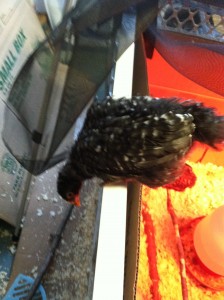
I finally reached a point where everything was together enough that the chickens could go out to their new home. There were some finishing touches that needed to be taken care of, but these weren’t anything that would affect the safety of the chickens so out they went. Of course, a few days before I was finished, my mother called to tell me that my uncle’s flock had just been wiped out by a raccoon and that he felt electric fences were the only way to go. I located a small, battery powered one just in time, and Chicken Fort Knox was all set. We put them out, and for days I could hear them pecking the inside of the coop, which is how they feel for their surroundings. That, to me, was the sound of success. To everyone else it was probably just annoying.

